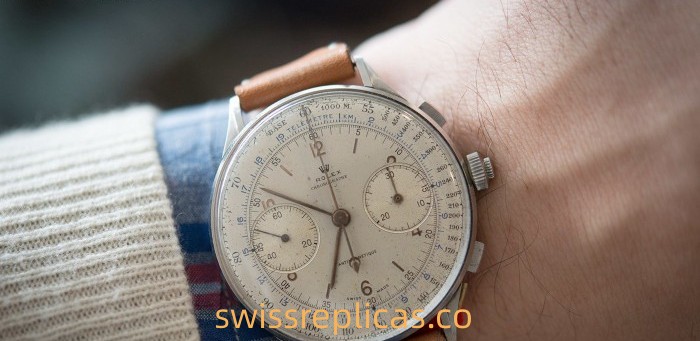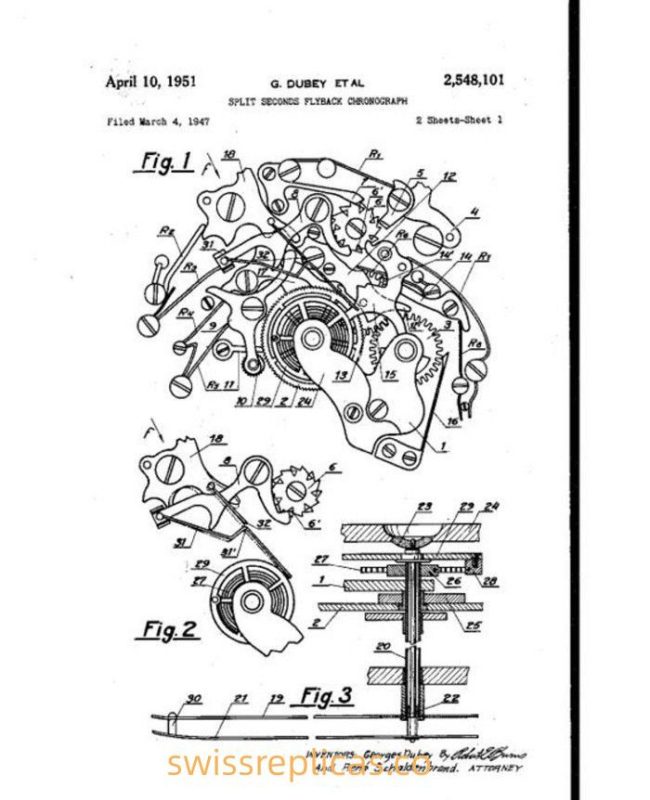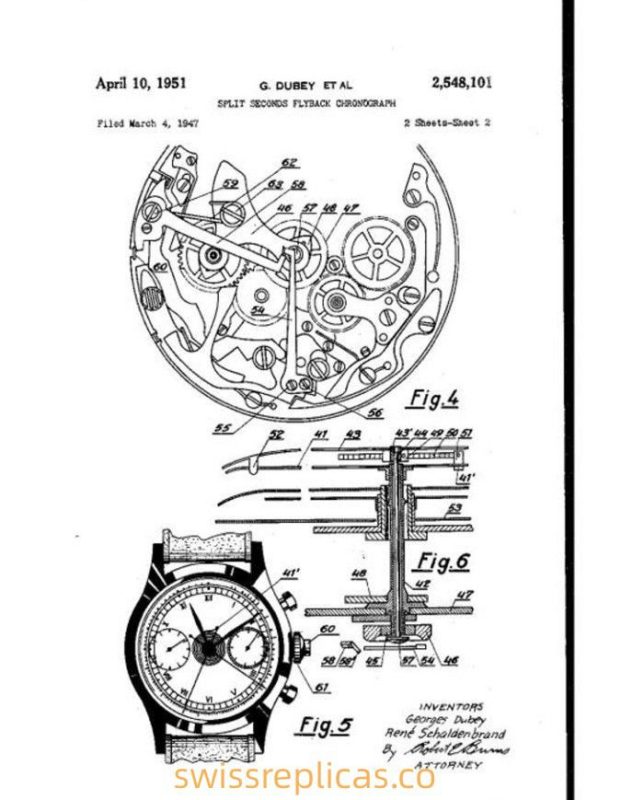Swiss Replicas
Rolex Ref.4113 And Index-mobile Mechanism, Rolex Copy Watches
Regarding split-second chronographs, we can’t help but mention the Rolex Ref. 4113. Undoubtedly, it is the most talked about, sought-after, and expensive split-second split-second chronograph in the Valjoux55 family. Ref.4113 was once the only Rolex watch sold for more than $1 million at public auction (sold for $1.17 million in 2013). It has raised this record to $2 million (in May 2016). The Artisan “Start-Stop-Reset” themed auction sold for 2.4 million Swiss francs). Ref.4113 is Rolex’s only double split-seconds chronograph. It was launched in 1942 with a production of only 12 pieces. This watch is enormous, with a diameter of up to 44 mm. Equipped with Valjoux55VBR movement, it is also the most advanced configuration.

Rolex Ref.4113
Rolex Ref.4113 split-seconds chronograph
Rolex Ref. 4113 no longer uses a single-button design – its central button is responsible for starting the clock, the button at 2 o’clock activates the double rattrapante hands, and the button at 4 o’clock is responsible for resetting the clock. Please note that previous versions equipped with the Valjoux55VBR movement cannot be “paused” (like all single-button split-second chronographs), but the Rolex Ref. 4113 has this function. Rolex Ref.4113 is the only two-button double-second chronograph equipped with Valjoux55VBR movement. Compared with other versions equipped with Valjoux55VBR movement, Rolex Ref. 4113 adds additional functions and has a relatively thin case. Rolex copy watches.

Rolex Ref.4113
Why was Rolex Ref.4113 made? This model was never released to the public or appeared in any of the brand’s advertising. But it was produced in 1942 in 12 pieces, serially numbered from 051313 to 051324.
Interestingly, most of the surfaced examples are inextricably linked to Sicily. For instance, in May 1991, Christie’s Geneva auctioned a Ref. 4113 numbered 051313 (sold for 82,500 Swiss francs), and the consignor was the family of the famous driver Stefano La Motta. For another example, in October 1991, Christie’s London auctioned a Ref. 4113 numbered 051318 (sold for 27,500 pounds). The client was a widow whose husband had worked for the team during his lifetime. Therefore, many speculate that this rare and famous double rattrapante clock deeply connects with motorsports. Today, Rolex Ref. 4113 is one of the most popular antique watches, evidenced by its history and auction results.
Butex split-seconds chronograph, Landeron split-seconds chronograph movement

Butex split-seconds chronograph
The picture above shows a Butex double rattrapante chronograph. From the overall layout of the lever, it can be inferred that the movement should come from the Landeron manufacturer. A puwatch’son activates the watch’s split-second mechanism at ten o’clock. The O’clock design is entirely different from the Venus and Valjoux movements but, coincidentally, is similar to modern split-second chronographs from IWC and A. Lange & Söhne. This type of watch is just like a traditional timepiece. They are not only a decoration on the wrist but also focus on functionality and are used for timing.

Butex split-second chronograph movement
Beyond that, the mechanical complexity of the movement is astonishing. They are undoubtedly among the most impressive and complex watch movements in history. They can even be called one of the two ultimate mass-produced vintage collectible chronograph movements, the other being the Longines 13ZN. If retouching is not considered, 13ZN may be superior in aesthetics and design, but the complexity of Venus185/Valjoux55VBR is better than life.
BOVET Valjoux84Mono-Rattrapante
The demand for double rattrapante chronographs is actual, but due to cost and price, it is difficult for conventional double rattrapante chronographs to benefit the general public. Moreover, the mechanical mechanism of a split-second chronograph is very complex, so you can imagine how difficult maintenance services are. As a result, industry players began to consider producing more economical and accessible products to adjust to movements. The first is the Valjoux84 movement powered by Bovet watches in the 1940s.

BOVET Valjoux84Mono-Rattrapante
As mentioned earlier, the mechanical mechanisms of the Venus185 movement and the Valjoux55VBR movement are equipped with double rattrapante hands. In 1936, Charles Jeanrenaud-Bovet of Fleurier obtained a patent for a clock (patent number no. 185465). The clock was only equipped with a second hand, but its functionality was similar to a split-second chronograph. It’s caIt’s the “Mono-R” trapan,” with “he “Mono” “ever” ing to a single second hand.

Valjoux84 movement
At first glance, the Valjoux84 movement looks very similar to the early single-button version of the Valjoux22 movement. However, we can quickly notice the additional coil spring at nine o’clock o’clock o’clock, the critical element that allows the chronograph movement to give a secondhand a “catch-“p” mecha “ism.

BOVET Valjoux84Mono-Rattrapante
Press the button at two o’clocko’clockrt the chronograph mechanism; press and hold the button at four o’clocko’clock; the second hand will pause, but the chronograph mechanism is still running. During this time, the coil spring gradually builds up tension. Release the button at four o’clock. The spring releases the stress, and the second hand will “catch “p” with “the elapsed time. However, because the “catch-“p” mecha “ism is connected to the small stud that pulls the coil spring, the time you can hold and release the pusher at four o’clocko’clockited to 60 seconds (the time it takes for the second wheel to make one revolution). The small studs will block the gears any longer, and the entire movement will stop.

LowenthalMono-Rattrapante
This mechanism works because it allows the user to record the time of an event while the timing mechanism continues to track elapsed time. It is functionally equivalent to a split-seconds mechanism but does not require a second second hand. It is simpler and easier to produce, adjust, and service. In addition, this mechanism can also be used in other single-pusher movements. For example, some watches produced by Lowenthal have similar mechanisms. Bell and ross replica.
Dubey&SchaldenbrandIndex-Mobile mechanism
Bovet’s use of a tension spring mechanism is an interesting horological innovation, and the watchmaking community is equally interested in using similar technology to produce a split-second chronograph watch. In 1948, Georges Dubey and Rene Schaldenbrand obtained a patent (patent number no. 253051), which used studs and tension springs to install on the Valjoux77 movement but added secondhand and a tension spring under the central chronograph gear. Its function is similar to that of the tension spring equipped with Valjoux84. The pair subsequently obtained two more patents, each simplifying the original system. The second and final patent enabled a universal mono-pusher chronograph movement to realize the double split-second mechanism. This patent eventually developed into the Dubey & Schaldenbrand Index-Mobile mechanism.

Dubey&SchaldenbrandIndex-Mobile
So how does it work? Index-Mobile has an additional coil spring installed above the dial and connected to the second hand. Generally speaking, conventional double split-second chronograph movements require large-scale modifications inside the movement; at the same time, the Dubey & Schaldenbrand Index-Mobile mechanism transfers most of the modification work to the outside of the movement, moving it to the dial and essential modifications within the movement. Add an extra center gear and lever. The gear is connected to the secondhand and the original central gear via a spring. Pressing the button at three o’clock o’clock ever stops the gear and the second hand, allowing the time of the first event to be read. If desired, the pusher can be released, and the second can “catch “p” with “he still-running firsthand via a spring on the dial. Its basic principle is similar to Bovet but achieves an actual double rattrapante chronograph function.

IndexMobile mechanism patent
This mechanism (compared to the Valjoux84) is undoubtedly more cost-effective because it adds additional components to the base movement without modifying the entire movement. Compared with the traditional split-second chronograph movement, the IndexMobile mechanism movement is cheaper to produce. Compared with the Valjoux84 movement, the functionality of the IndexMobile mechanism movement is almost intact, although the latter is also subject to a similar problem within 60 seconds. Restrictions.

IndexMobile mechanism patent
Interestingly, most Bovet Valjoux84 watches have chrome cases and fewer steel ones. A small number of the Mono-Rattrapante watches produced by Lowenthal have solid gold cases, and although they are scarce, the value of these watches depends mainly on the state of care. Strangely, there is no particular reason. Still, the demand for D & S Index-Mobile mechanical watches is significantly lower than that of Valjoux84 watches, possibly because of the large number of gold-plated D & Swatches. Regardless, the IndexMobile mechanism is a fascinating horological invention that deserves attention and recognition.

Dial Color: Brown Dial
Case Thickness: 12mm
Band Width: 20mm
Brand: Rolex
Gender: Men’s
Model: 118135
Band Length: 18cm
Series: Day-Date

